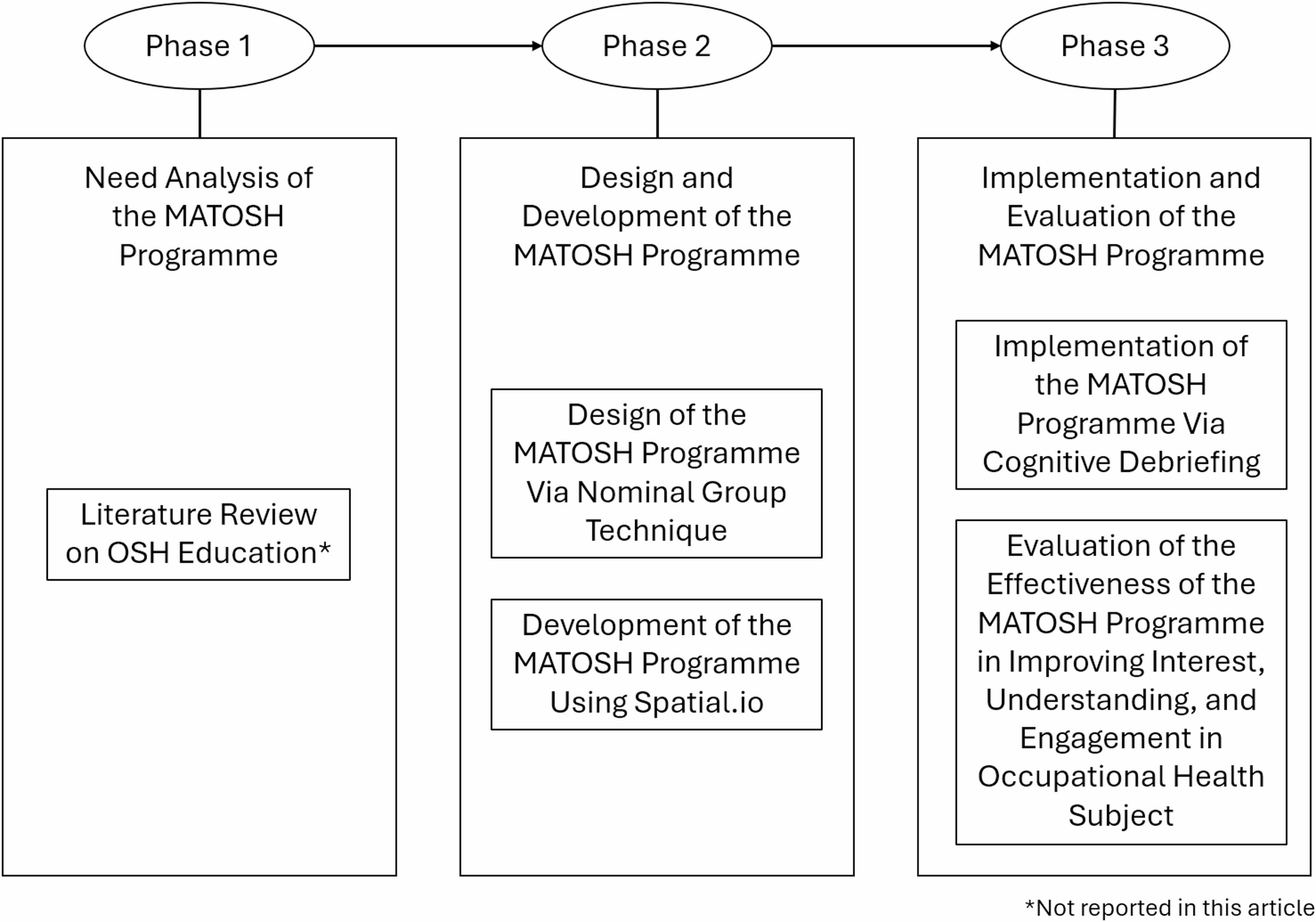Boosting Engagement: Metaverse in Occupational Health for Gen Z Students

Innovative metaverse Program Enhances Medical Students’ Engagement in Occupational Health
Overview of the Study Phases
This research was executed in three distinct phases, following the Design and Development Research (DDR) framework. The initial phase, not detailed in this report, involved a comprehensive literature review to pinpoint deficiencies in students’ interest, comprehension, and engagement with the occupational health curriculum, highlighting the necessity for a new educational program. The second phase focused on creating a metaverse initiative called MATOSH, while the final phase assessed its effectiveness in enhancing medical students’ interest, understanding, and engagement in occupational health.
- Overview of the Study Phases
- Phase 2: Design and Development of MATOSH
- Study Framework and Participants
- Sample Size and Selection Criteria
- Recruitment Methodology
- Tools and Resources Used
- Methodology of the Study
- Statistical Analysis Approach
- Phase 3: Implementation and Evaluation of MATOSH
- Study Design and Participant Selection
- Sample Size Calculation
- Recruitment Strategy
- Evaluation Instruments
- Implementation Procedure
- Statistical Analysis for Evaluation
- Ethical Considerations
Phase 2: Design and Development of MATOSH
Study Framework and Participants
The design of the MATOSH program utilized the nominal group technique (NGT). Participants included third-year medical students from the Faculty of Medicine at the National University of Malaysia, chosen because they were encountering the occupational health subject for the first time during their public health training. The development process involved collaboration between academic staff and students, all conducted through virtual meetings.
Sample Size and Selection Criteria
A total of 15 medical students and one occupational health lecturer participated in the NGT to determine the five most critical topics for inclusion in MATOSH. The development team comprised three academic professionals and three medical students.
Recruitment Methodology
Participants for the NGT were selected through purposive sampling, utilizing a list provided by the public health posting coordinator. Inclusion criteria required students to have completed the public health posting, attended a minimum of 75% of occupational health lectures, and have access to a metaverse platform. Exclusions applied to those who had failed the public health posting or declined to consent to participate.
Tools and Resources Used
To identify the key occupational health topics for MATOSH, an interview schedule was crafted, posing a central question about essential topics for teaching. The development of MATOSH was facilitated using a password-protected laptop and online platforms such as Spatial.io and Sketfab.com for creating the virtual environment and avatars, respectively.
Methodology of the Study
During the NGT, participants gathered in a meeting room where they were briefed on the objective of identifying crucial occupational health topics. The process began with silent idea generation, followed by a round-robin sharing session where participants presented their ideas. The facilitator recorded all suggestions, which were later reviewed and consolidated. Participants then ranked the topics based on importance, leading to a consensus on the top five topics that would shape the MATOSH content.
Once the topics were established, the development of the MATOSH program followed a structured seven-step process. This included defining the metaverse concept, establishing technological requirements, designing virtual environments, integrating social interaction features, and developing a non-profit educational tool. The final steps involved testing and optimizing the program based on feedback, culminating in the launch of MATOSH on Spatial.io.
Statistical Analysis Approach
In the NGT, scores for each topic were calculated and converted to percentages to identify the top five topics. Descriptive statistics were employed to summarize the ranking data, focusing on reaching a group consensus rather than hypothesis testing.
Phase 3: Implementation and Evaluation of MATOSH
Study Design and Participant Selection
The third phase comprised the implementation and evaluation of MATOSH’s effectiveness in enhancing medical students’ engagement with occupational health. This phase spanned nine months, involving cognitive debriefing to validate the program and a quasi-experimental design for evaluation.
Sample Size Calculation
Based on previous engagement scores, a sample size of 208 students was initially targeted, but due to non-responses, the final evaluation included 88 students in the intervention group and 84 in the control group.
Recruitment Strategy
Medical students were again recruited through purposive sampling, with similar inclusion criteria as in Phase 2. Exclusions applied to students repeating the public health posting or those who did not consent to participate.
Evaluation Instruments
For the cognitive debriefing, a semi-structured interview schedule was developed to assess various aspects of the MATOSH program. The evaluation utilized three tools: the Study Interest Questionnaire (SIQ), the Occupational Health End of Module (OH-EOM) test, and the Student Course Engagement Questionnaire (SCEQ) to measure students’ interest, understanding, and engagement.
Implementation Procedure
Fifteen medical students participated in cognitive debriefing, exploring the MATOSH program on their devices before engaging in interviews to provide feedback for improvements. The evaluation involved a control group receiving traditional lectures and an intervention group experiencing both lectures and the MATOSH program.
Statistical Analysis for Evaluation
Qualitative data from cognitive debriefing were analyzed thematically, while descriptive statistics outlined participant demographics. Continuous data were analyzed using paired t-tests for within-group comparisons and independent t-tests for between-group comparisons, with a significance level set at p < 0.05.
Ethical Considerations
The study received ethical approval from the National University of Malaysia’s Ethics Committee. Participants were provided with information about the study and required to give informed consent. No personal identifiers were collected, ensuring confidentiality and data security, with data retained for five years post-study.
This innovative approach to integrating a metaverse program into medical education represents a significant advancement in engaging students in occupational health, potentially transforming how this critical subject is taught.







